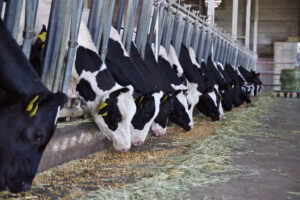Spices are plant extracts regularly used in our daily lives. Apart from their gustatory properties, they have many virtues for which they have been used by many for centuries. Spices combine the useful with the pleasant!
In animal feed, they are becoming more and more present. In particular, chillies of the Capsicum family are known for their numerous beneficial effects on feed intake and water consumption in situations of heat stress. But chili is not the only “hot” spice of interest to livestock. Several other compounds are proving to be as relevant.

Spicy spices: it’s all about language.
The definitions of a spice are many and varied. “Spices” refer to a large category of ingredients of plant origin used in various forms:
– Powder,
– Grains,
– Oils,
– Dried fruits
The adjective “spicy” refers to a flavour that is rather pungent and hot.
Hot feed coming through!
This burning sensation is caused by different molecules contained in these spices: it is the pseudo-heat. The sensation of temperature change is triggered by the activation of oral receptors connected to trigeminal nerves. This mechanism is chemesthetic: the sensation is induced by a sensitive perception and not a gustatory or olfactory one: temperature change, texture or pain. The sensation can be cold (menthol) or hot (mustard, garlic, pepper): this is what is often called “spicy”.
Flavors of the world
Generally, we tend to call “spicy” a flavour related to the presence of one or more spices. We find the same trend in English with “spice” & “spicy”, while in Spanish we speak of “picante”. In Arabic, the word “har (حار)” is used for both hot and spicy foods. In English, again, “hot” is preferred to “spicy” to indicate the level of spiciness. It is the notion of heat that is associated with this sensation!
The ingredients extracted from the stems and leaves are excluded from the “spices” category and are more referred to as “aromatics” or aromatic herbs.
And in the mouth of animals?
One might think that the spicy flavour would cause animals to reject it. In fact, the molecules that cause the burning sensation are secondary plant defense metabolites. Taste is one of the senses put forward to determine the danger of consuming a plant. But all is a matter of dosage. Certain molecules are known for their apperitising effect, even for the animal. The consumption of certain spice mixtures, stimulated by this appetising action, leads to a hedonic effect (search for pleasure and avoidance of suffering) pushing the animals to a state of “well-being”. But not mastering this mixture well can also lead to the opposite effect.
What are the physiological mechanisms?
More precisely, the “burning” spicy flavour is due to molecules, which by their mode of action, imitate the sensation of danger and pain: it is caused by the activation of thermosensitive and chemosensitive TRP ion channels, in particular the nociceptors (pain “alarm” receptors) TRPV1 (Transient Receptor Potential Vanilloid 1) and TRPA1 (transient receptor potential ankyrin 1), present on the skin but also on the mucous membranes all along the digestive tract. These receptors, which are usually activated by temperatures above about 42°C, are directly activated by specific molecules such as capsaicin, thus causing a painful burning sensation followed by an adapted physiological response. These alerts may cause the brain to release endogenous analgesic compounds, thus improving the state of relaxation in the animals.
Spices have many benefits for your livestock
In the same way as in human food, spices present an interest through their neurosensory and physiological action described above. If chili and in particular its capsaicin are used for their vasodilator effect (heat evacuation), ginger, for example, has sialogogues properties (increasing saliva production). Turmeric, the “miracle spice”, is equally effective in animals too for its protection of the intestine, and is a mean to fight oxidative stress. Furthermore, spices are great allies of the digestion. Many of them, such as pepper, ginger or turmeric, are known for their ability to stimulate the secretion of digestive enzymes (lipase, amylase, protease), promoting efficient digestion, and allowing the regulation of blood sugar and lipid levels, and thus promoting an optimal metabolic state. Finally, they reinforce the intestinal barrier against pathogens, facilitating the management of common problems in breeding such as coccidiosis.
How to make the most of them?
While these spices are interesting, they can be found in several forms and extracts on the market. But using them is not easy; care must be taken when handling them and the dosage must be suitable . It is therefore necessary to find the right balance between palatability, benefit and, of course, spiciness for your livestock. Poor control of this dosage can sometimes lead to animals refusing to eat or to situations of strong discomfort or even burns for those handling these powdered products. Here again, the know-how of companies, especially in terms of protection of active ingredients is essential. Moreover, spices have their individual properties, but using them together can multiply their respective benefits, while lowering their dosage. It’s all about synergy!





